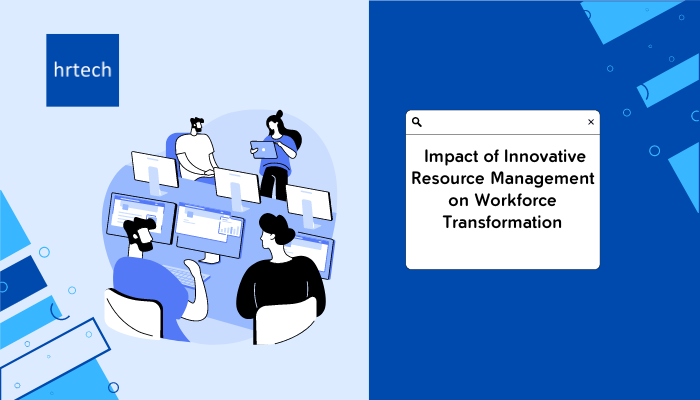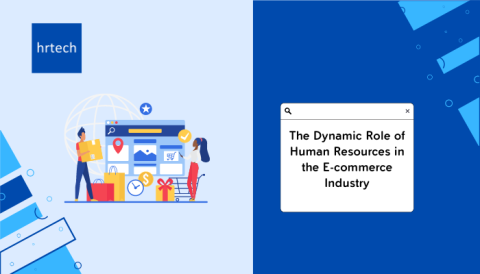Human Resource Management is undergoing a pivotal shift from traditional methods to innovative strategies. The role of innovative resource management is critical for modern workforce development. This blog explores how innovative resource management and advanced HR technologies are reshaping organizations.
Evolution Of Human Resources Technology:
HR technology has come a long way from its humble origins as basic payroll systems to encompass a wide range of functions. Technological advancements have played a significant role in shaping the HR landscape, enabling organizations to streamline their operations and create a dynamic workplace culture. HR technology has evolved into a comprehensive ecosystem that addresses the complex needs of both HR professionals and employees. Key features of modern HR technology include data analytics, AI, automation, and collaboration tools.
As AI and automation continue to transform HR processes, organizations must appreciate this ongoing evolution to remain competitive and support their workforce effectively. The future holds even greater potential for HR technology, with the potential to improve efficiency, enhance the employee experience, and drive overall business success.
Concept Of Innovative Resource Management:
Innovative resource management is a strategic approach that integrates generating new ideas, products, and services to add value to the organization. It’s about engaging employees at all levels, fostering cross-functional collaboration, and utilizing tools like AI and data analysis. This approach is vital for organizations to remain competitive in dynamic environments, driving growth and responding effectively to market changes.
Role Of Innovative Resource Management In Workforce Transformation:

Discussing transformations such as remote work, decentralized workforce, diversity and inclusion, etc.: Innovative resource management is critical in addressing the challenges posed by transformations such as remote work, decentralized workforce, diversity and inclusion, etc. It enables organizations to leverage advanced technologies, such as AI, data analytics, and automation, to streamline HR processes, enhance employee engagement, and create a dynamic workplace culture.
Case studies demonstrating effective utilization of innovative resource management to instigate workforce transformation: Case studies of organizations that have effectively utilized innovative resource management to instigate workforce transformation can provide valuable insights into the benefits of this approach. These case studies could highlight how innovative resource management has enabled organizations to adapt to changing market conditions, improve employee engagement, and drive business growth.
Impact of Innovative Resource Management on Various HR Functions:
The impact of innovative resource management on various HR functions is substantial, influencing recruitment and onboarding, training and development, performance management, HR analytics, employee engagement, and wellness. Innovative resource management strategies and technologies are essential for shaping the future of HR, enabling organizations to streamline operations, create a dynamic workplace culture, and improve employee engagement and retention.
Research has shown a positive relationship between innovative HRM practices and organizational innovation, emphasizing the importance of innovative resource management in driving organizational success.
Innovation management, a related concept, aims to nurture a sustainable innovation process within an organization, offering benefits such as improved business performance, enhanced customer retention, and quick problem-solving. Overall, innovative resource management is integral to HR functions and organizational success, particularly in today’s competitive and rapidly evolving business landscape.
Analyzing The Benefits And Challenges Of Implementing Advanced HR Tech:
- Comprehensive benefits of innovative resource management for organizations and employees: Innovative resource management can lead to improved efficiency, productivity, and adaptability in the workforce. It enables organizations to leverage advanced technologies, such as AI, data analytics, and automation, to streamline HR processes, enhance employee engagement, and create a dynamic workplace culture.
- Potential obstacles and challenges in implementing new technologies: Implementing advanced HR tech can be challenging due to factors such as resistance to change, lack of technical expertise, and the need for significant investment in infrastructure and training.
Strategies for a smooth transition from traditional resources to innovative resources: To successfully implement innovative resource management, organizations should develop a clear implementation plan, allocate sufficient resources, provide adequate training and support, and continuously monitor and evaluate the effectiveness of the new technologies.
Case Study: Successful Implementation of Innovative Resource Management
One example of a company successfully implementing innovative resource management is IBM. IBM has been at the forefront of HR innovation, leveraging advanced technologies such as AI, data analytics, and automation to streamline HR processes, enhance employee engagement, and create a dynamic workplace culture.
IBM has implemented various innovative HR practices, such as using AI-powered chatbots for recruitment and onboarding, virtual reality simulations for training and development, and data analytics for performance management. These innovative practices have helped IBM transform its HR functions, improving efficiency, productivity, and employee engagement.
Lessons learned from this case study include the importance of investing in advanced HR technologies, developing a clear implementation plan, and providing adequate training and support to employees. IBM’s success in implementing innovative resource management demonstrates the potential benefits of this approach, including improved business performance, enhanced customer retention, and increased employee engagement and retention.
Transforming HR through Agile Workforce Solutions
Future- Continued Workforce Transformation Through InnovativeResource Management:
Outlook for the future of HR technology in shaping workforce transformation: The future of HR technology is likely to be characterized by the increasing use of AI, data analytics, and automation to streamline HR processes, enhance employee engagement, and create a dynamic workplace culture. HR technology will continue to evolve, enabling organizations to adapt to changing market conditions, respond to market disruptions, and meet the evolving needs and expectations of customers.
The evolving role of HR professionals in this changing scenario: The evolving role of HR professionals in this changing scenario will require them to develop new skills, such as data analytics, AI, and automation, to effectively leverage advanced HR technologies. HR professionals will need to become strategic partners, driving innovation, and creating value for the organization.
How organizations can stay ahead in the HR technology game: To stay ahead in the HR technology game, organizations must invest in advanced HR technologies, develop a clear implementation plan, provide adequate training and support to employees, and continuously monitor and evaluate the effectiveness of the new technologies. Organizations must also foster a culture of innovation, creativity, and collaboration, empowering employees to develop new ideas, products, and services that drive business growth and create value.
Conclusion:
The impact of innovative resource management in transforming HR is significant. We encourage readers to share their experiences with innovative resource management or reach out for professional advice. Let’s collectively navigate this evolving landscape to foster a dynamic and efficient future in workforce management.





